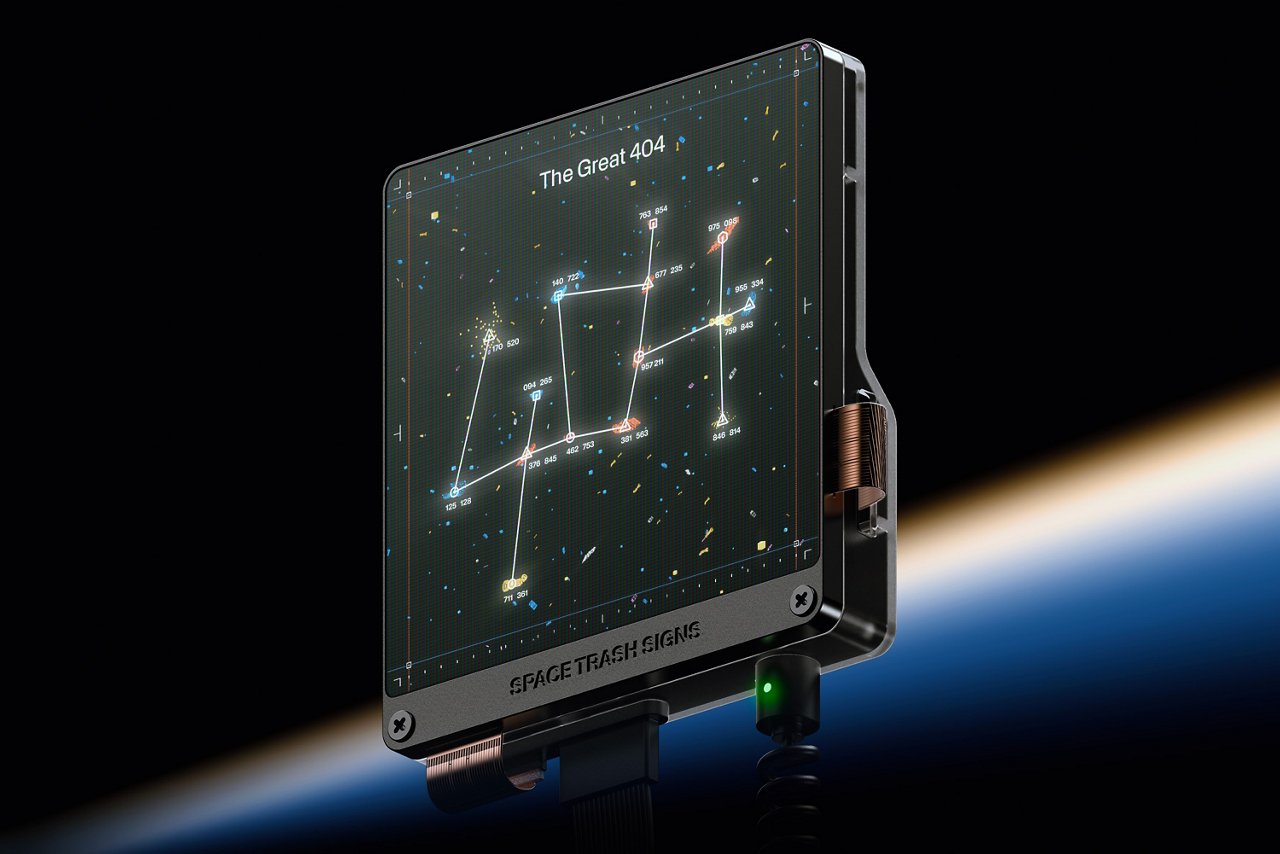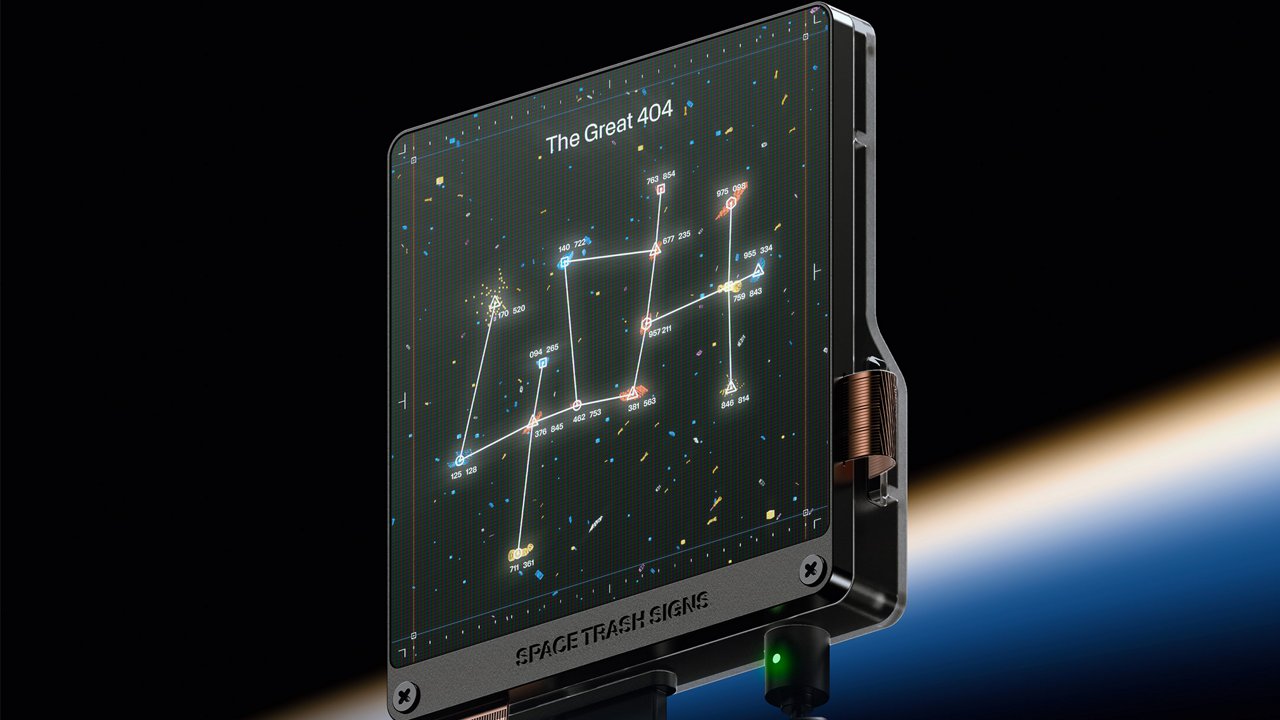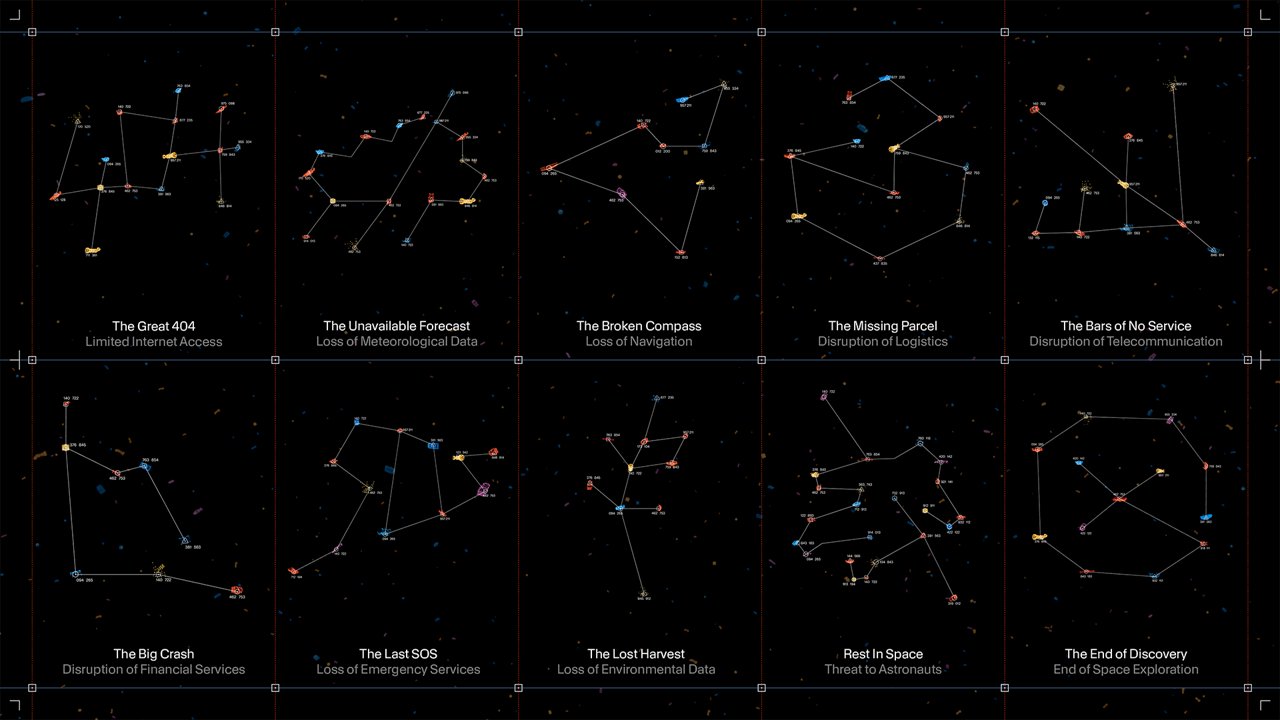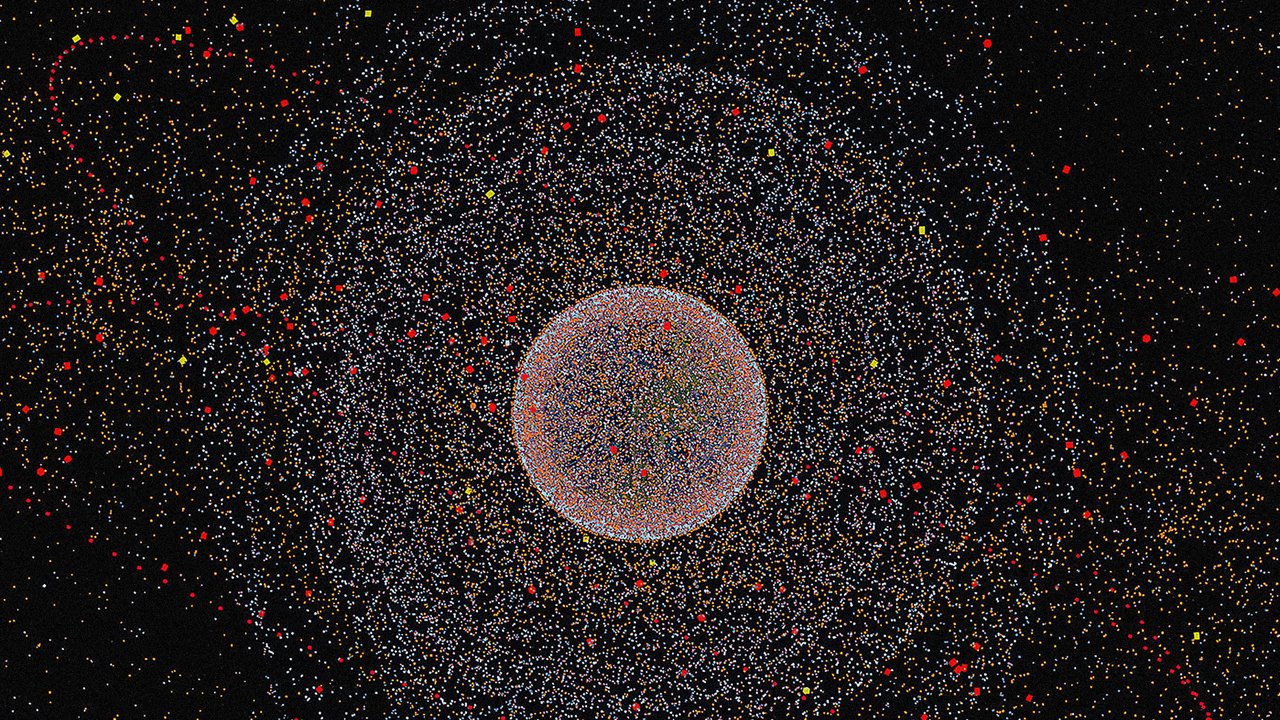Space Trash Signs

Space Trash Signs Visualize Consequences of Space Pollution
15.04.2024
Munich, 15 April 2024 — Space exploration is booming. But with it comes the problem of trash. There are over 160 million pieces of human-made space debris in the Earth’s orbit. As they travel at high speeds of 15 kilometers per second, even a small piece can cause significant damage. Space pollution threatens to destroy satellites and other space infrastructure crucial for life on Earth, such as telecommunication, navigation, disaster management, environment protection, agriculture, financial services, and more.
In a groundbreaking world first initiative, Serviceplan Innovation have collaborated with design studio Moby Digg and Eat, Sleep + Design on ‘Space Trash Signs’, constellations made of space debris data. The Space Trash Signs were identified in partnership with Privateer, the Steve Wozniak co-founded space observation company, and the initiative is aimed at drawing attention to the problem of space pollution ahead of the United Nations Committee on the Peaceful Uses of Outer Space (UN COPUOS) in June 2024.
“There are some internationally agreed upon guidelines on debris clean-up and prevention. But none of these mechanisms has enforceability. If we don’t change our behavior, space will become unusable.”
— Dr. Moriba Jah, Chief Scientist, Privateer
Space Trash Signs is a platform open for any private or public organization as well as individuals who want to join the fight against space pollution. Experts from European Space Agency have recognized the important contribution of Space Trash Signs to raise awareness on the issue of space debris. Other prominent supporters include the German scientific aerospace association WARR, US-based space monitoring company Privateer, Japanese founded, global debris-removal innovator Astroscale, several space-debris related startups such as OKAPI:Orbits from Germany, Dark Space from France and Digantara from India, global astronomical society Astronomers Without Borders, as well as the world’s biggest science museum Deutsches Museum in Munich.
“We know how to solve this problem. What we need is public support to change policy.” Alex Godfrey, Business Development Manager, Astroscale
“Space Trash Signs is a great way to raise awareness on what is going on in space and motivate more people to get involved. At OKAPI:Orbits, we have been advocating on space sustainability since 2018, and we are very happy to have supported this initiative.” Kristina Nikolaus, CEO and Co-Founder, OKAPI:Orbits
Ten consequences, impacting 8 billion people
The Space Trash Signs initiative aims to raise awareness about space pollution ahead of the UN COPUOS session in June 2024. Launched with the support of aerospace companies and space agencies, scientists and universities, as well as activists, museums and media from around the world, the initiative proposes nothing less than new astronomical constellations, made of space debris. Each of these “trash signs” represents a different impact of space pollution.
For example: “The Broken Compass” signifies the loss of navigation services such as GPS, that would affect 6.5 billion people and make modern aviation impossible. “The Great 404”, named after the ‘page not found’ error in the web browser, signifies limited internet, impacting 43 million people who rely on satellite internet, potentially isolating whole communities. “The Lost Harvest” stands for the loss of environmental data that can only be collected through satellites, affecting 509.6 million square kilometers of land and potentially causing famine and environmental disasters.
“Since the dawn of time, humans have looked up to the stars for meaning. Space Trash Signs builds on this universal insight, to educate the public about space pollution — a topic that affects us greatly, yet no one talks about. It’s our responsibility as communication experts to change that.” Alex Schill, Chief Creative Officer, Serviceplan Group
Built with real-time data and astronomical precision
The Space Trash Signs were identified in partnership with Privateer, the Steve Wozniak co-founded space observation company. Privateer collects over 800 million data points on objects in the Earth’s orbit every day. This includes the position, speed, country of origin, parent object, size, shape, and even the estimated removal cost. AI was then used to scan datapoints and identify constellations based on shape, origin, and location.
For example: “The Lost Harvest” was located over the Amazon rainforest, the world’s most biodiverse region. “The Great 404” over Burundi, Central Africa, the country with the lowest number of internet users. “The Broken Compass” over the infamous Bermuda Triangle in the North Atlantic.
“Privateer is all about increasing knowledge about our home, Gaia, through the lens of space. We’re happy to support Space Trash Signs with our data and expertise in the mission to increase awareness for space pollution.” Dr. Moriba Jah, Chief Scientist, Privateer
Bringing the signs to life
Space Trash Signs are brought to life for the whole world to experience: immersively in over 700 planetariums worldwide through partnerships. The signs are also integrated into popular AR star-gazing apps. Furthermore, a digital campaign developed with Mediaplus confronts people with the consequences of space pollution through staged website error pages, failed parcel tracking or missing forecasts. All leads to the Space Trash Signs website, where all signs can be explored along with more data, background information and ways to act, such as signing the Zero Debris Charter facilitated by the European Space Agency and co-developed with more than forty space actors around the world.
"Experiencing Space Trash Signs in the planetarium makes the topic and the problem of space pollution even more accessible to the public.” Dr. Susanne Hüttemeister, Director, Bochum Planetarium
“Space Trash Signs makes this huge problem of space debris tangible to the public. It’s important for ESA to recognize the role of such initiatives to educate people about space debris and unite us all for a zero debris future.” Dr. Quentin Verspieren, Space Safety Programme Coordinator, European Space Agency
To download the mediakit, click here.
About the creators
Space Trash Signs was created by Serviceplan Innovation together with Moby Digg, Eat, Sleep + Design, Jürgen Branz, kimera, Non Zero, and Mediaplus Group. Serviceplan Innovation (SP.IO) is the R&D unit of Serviceplan Group, one of the world’s leading independent communication agencies with offices around the world. Moby Digg is a design agency that develops global brands. Eat, Sleep + Design is an award-winning design studio based in Berlin. Jürgen Branz is a sound designer and composer based in Augsburg. kimera is an independent type foundry based in Munich. Non Zero is a CGI and design studio based in India. Mediaplus Group is a Serviceplan subsidiary and is the largest independent media agency in Europe.
Credits:
Serviceplan Innovation
Mediaplus Group
Eat, Sleep + Design
Moby Digg
Owls Department
Jürgen Branz
Christoph Groß
Peoplegrapher GmbH
Michael Clasen
kimera
Non Zero
Raghavendra Rao
Download
Here you can download the file.
- Filename
- SpaceTrashSigns_Visuals.zip
- Size
- 8 MB
- Format
- application/zip






